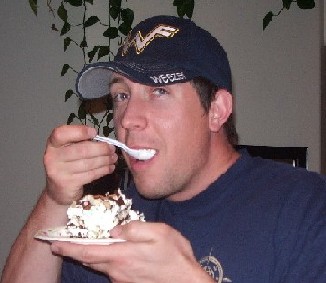The book is about how to get people to change (and really, how to get ourselves to change). Who wouldn't want a little help with this? Today, Joseph Grenny gave an introduction to the book and started with the first concept:
- The best way to improve results is not to focus on results, but the behaviors that produce them, and
- Even with complex and long-standing problems, just a few vital behaviors can lead to enormous change.
The authors looks at this questions and did a lot of research from famed influencers across the world. Dr. Hopkins who has worked to eliminate the Guinea worm from the world, Don Berwick who has successfully helped health care professionals reduced the number of deaths in hospitals, Mimi Silbert who has helped hardened criminals stay out of jail and out of trouble with a 91% success rate (all of these stories are found in the book).
What they found: They were able to identify key behaviors that when changed, let to HUGE change. He shared a story of how his 3-year-old asked him to help color one day. As he got down to color, his son instructed him on how to make a high-quality picture. You can scribble and go as fast as you want in the middle, but when you get near the lines, slowing down makes it much much better. The key there is that there are moments when you have to slow down and really focus on a particular thing. Little behaviors can have a big effect. So what we have to do is not focus on results so much, but what are the vital behaviors that get us to the results - like slowing down when you get to the lines. We have to find the lead domino that will lead to the other actions we want to do to get results.
How do you identify a vital behavior? It will be something that leads to results, beats self-defeating patterns, and causes other positive behaviors to follow naturally. Easy, right?
The trick is to look at your thing you want to improve (say becoming healthy and shedding some extra pounds) and looking for the crucial moments. You aren't tempted to eat junk 24/7, but usually at certain times of the day. So if you get snacky at 4:00 pm, you can focus there first. Here is where this gets really cool. Look for what they call positive deviance. Look for people who could have the same problem, but don't. They have figured something out (or you do research, or you look back at your own life when you didn't have the problem - what were you doing then that you aren't doing now). Find out what they do, and apply it. So you want to find who to look for as an example, figure out when those critical moments are when a different behavior might make a big difference downstream, and then find out what the positive deviants do during these moments that others don't.
For example Senor Grenny shared that when he is on the road, he struggled with exercising. So what is the crucial moment? He found that if he could set his alarm and get up at 5:30 and pull on his shorts and get to the front door of the hotel and take that first step, he would exercise. It is that series of events that improves his overall health. So then he would work with how to make that happen (upcoming).
The key then, is to realize that there is a good way to influence ourselves and others. And it starts by identifying the vital behaviors that lead to the results that we want. What one thing would make the biggest difference downstream if I could just do it. Then we can figure out how to do that one thing that will really start us off to the results we want. More to come . . .


1 comment:
Sounds intriguing...
Post a Comment